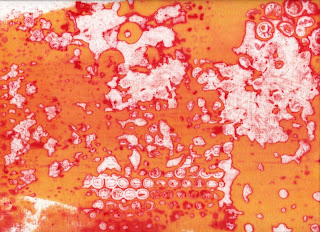A couple of evenings ago I decided that it was time to have a go at gelatin printing. A while back I downloaded Rayna Gillman’s workshop Gelatin Monoprinting, and on Thursday evening I prepared the print plate and watched Rayna’s workshop for inspiration.
As for the plate, I used a packet of Dr. Oetkers leaf gelatin, as that was the only brand I could find in my local supermarket. I used all 10 leaves in the packet with half a litre of water, which made the mixture slightly more concentrated than what the manufacturer recommended. I poured boiling water into a tin and mixed in the leaves, which had been soaked in water for about 10 minutes. The leaves melted instantly and made a lump and bubble free gelatine plate.
The gelatin print plate
As for Rayna’s workshop, I found it very entertaining. I kept bursting out into laughter, because Rayna’s approach is so far from the way I normally do things. I’m more like the people she refers to as neater and more organised. Not the back-to-kindergarten type. Or at least that's what I thought.
The gelatin plate is ready for action.
I put it on an old book cover (The Laws of Finland, as it happens -
I have my sources) in case I needed to move it about.
In action, though, the Truth is revealed. Or let’s put it like this: now I know what Rayna means. There’s something about gelatin printing that brings out the hidden kindergartener in you. After the initial disappointment with the results of my printing, it didn’t take more than 5 prints before I was applying the paint with my bare hands, not caring if the paint got under my nails. I thoroughly enjoyed smacking and rubbing the wobbly print plate, and there was something deeply satisfying about the messiness of it.
I quickly discovered that I liked working with a stencil, and I particularly liked the effects of ghost prints, so I made a whole series with the same stencil.
Stencil printing, paint applied with fingers (a little too much paint on this one)
Ghost print. I like the ethereal and distressed look of this print.
Stencil printing. I placed the stencil so that the side which had paint on it from the last print was facing upwards. I like the contrast between the smooth background and the more textured area from the paint-coated stencil.
Another ghost print. I really like them.
Unfortunately the gelatin plate started to disintegrate a little too soon. After 5 prints the top layer of one corner came off, after 10 prints I was scraping off chunks of gelatin from my prints and after 15 prints I decided to call it a day. Perhaps this is normal. I have no idea how long a gelatin plate is supposed to hold up. But the next time I will try to add a few more gelatin leaves, as the plate did seem a little soft to me.
The print plate has done its job and big chunks of gelatin have come off
in the process. I made some of the cracks myself to create texture,
when the print plate was falling apart anyway.
Now I just need to figure out how to make the paint permanent. According to Rayna, ironing on gelatin is not advisable (apparently it smells, and there’s also a risk of burning), so I will let the paint cure for a few days, carefully wash off the gelatin and then hit the print with an iron.
A collection of the prints I made
















































